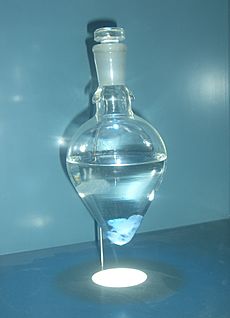Avery–MacLeod–McCarty experiment facts for kids
The Avery–MacLeod–McCarty experiment was a very important scientific study. It happened in 1944. Scientists Oswald Avery, Colin MacLeod, and Maclyn McCarty showed that DNA is the substance that causes bacterial transformation. This means DNA can change how bacteria behave.
This experiment built on earlier work from the 1930s and 1940s. Scientists at the Rockefeller Institute were trying to find out what caused "transformation." This idea first came from Griffith's experiment in 1928. In Griffith's study, he found that something from dead bacteria could make harmless living bacteria become dangerous.
Before Avery, MacLeod, and McCarty's work, many scientists thought that proteins carried genetic information. But their 1944 paper suggested that DNA, not protein, was the material that passed traits from one generation to the next in bacteria. They also thought DNA might work like genes or viruses in more complex living things.
This experiment was a huge step forward in biology. However, the three scientists did not receive the Nobel Prize for their discovery. Despite this, Nobel laureate Arne Tiselius later said that Avery was one of the most deserving scientists who never got the Nobel Prize.
Contents
What is Bacterial Transformation?
Bacterial transformation is a process where bacteria take up new genetic material from their surroundings. This new material, often DNA, can change the bacteria's traits. Think of it like a bacterium finding a new instruction manual and learning a new skill.
Griffith's Discovery
In 1928, Frederick Griffith did an experiment with bacteria called Streptococcus pneumoniae. These bacteria can cause pneumonia. He found two types:
- One type was dangerous and caused sickness (virulent).
- The other type was harmless (non-virulent).
Griffith discovered that if he mixed dead dangerous bacteria with living harmless bacteria, the harmless bacteria became dangerous. It was as if something from the dead bacteria "transformed" the living ones. But he didn't know what that "something" was.
The Avery-MacLeod-McCarty Experiment
Avery, MacLeod, and McCarty wanted to find out what this "transforming principle" was. They thought it might be DNA, protein, or something else.
How They Did It
The scientists took the dangerous bacteria and broke them open. Then, they carefully separated the different parts of the cells. They got:
- Proteins
- DNA
- RNA (another type of genetic material)
- Other cell parts
They then added each of these parts to dishes containing the harmless bacteria.
What They Found
- When they added proteins to the harmless bacteria, nothing happened. The bacteria stayed harmless.
- When they added RNA, nothing happened.
- But when they added DNA from the dangerous bacteria, something amazing happened! The harmless bacteria changed and became dangerous.
This showed that DNA was the "transforming principle." It was the substance that carried the instructions to make the harmless bacteria dangerous.
Why This Experiment Was Important
This experiment was a major breakthrough. It provided strong evidence that DNA is the genetic material. Before this, many scientists believed proteins were responsible for carrying genetic information. The Avery-MacLeod-McCarty experiment helped pave the way for future discoveries, like the structure of DNA by Watson and Crick in 1953. It showed that DNA holds the blueprint for life.
Images for kids
-
Maclyn McCarty (with Watson and Crick)
See also
 In Spanish: Experimento de Avery-MacLeod-McCarty para niños
In Spanish: Experimento de Avery-MacLeod-McCarty para niños





